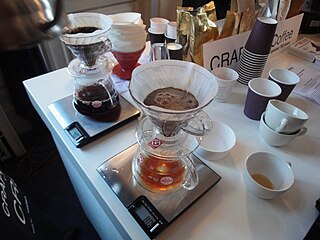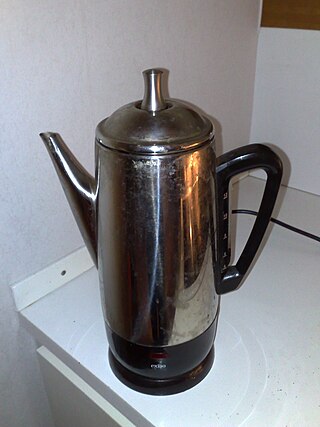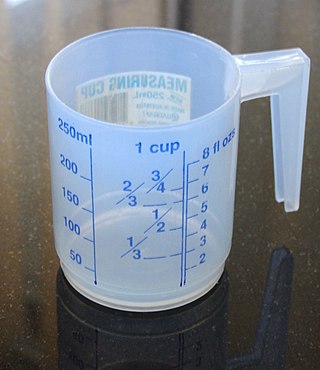
A French press, also known as a cafetière, cafetière à piston, caffettiera a stantuffo, press pot, coffee press, or coffee plunger, is a coffee brewing device, although it can also be used for other tasks. The earliest known device was patented in 1852 in France by Jacques-Victor Delforge and Henri-Otto Mayer.

Drip coffee is made by pouring hot water onto ground coffee beans, allowing it to brew while seeping through. There are several methods for doing this, including using a filter. Terms used for the resulting coffee often reflect the method used, such as drip-brewed coffee, or, somewhat inaccurately, filtered coffee in general. Manually brewed drip coffee is typically referred to as pour-over coffee. Water seeps through the ground coffee, absorbing its constituent chemical compounds, and then passes through a filter. The used coffee grounds are retained in the filter, while the brewed coffee is collected in a vessel such as a carafe or pot.

A coffee percolator is a type of pot used for the brewing of coffee by continually cycling the boiling or nearly boiling brew through the grounds using gravity until the required strength is reached. The grounds are held in a perforated metal filter basket.
Sunbeam Products is an American company founded in 1897 that has produced electric home appliances under the Sunbeam name since 1910. Its products have included the Mixmaster mixer, the Sunbeam CG waffle iron, Coffeemaster (1938–1964) and the fully automatic T20 toaster.

Newell Brands Inc. is an American manufacturer, marketer and distributor of consumer and commercial products. The company's brands and products include Rubbermaid storage and trash containers; home organization and reusable container products; Contigo and Bubba water bottles; Coleman outdoor products; writing instruments glue ; children's products ; cookware and small appliances and fragrance products.
Hamilton Beach Brands Holding Company is an American designer, marketer and distributor of home appliances and commercial restaurant equipment marketed primarily in the United States, Canada, and Mexico, including blenders, mixers, toasters, slow cookers, clothes irons, and air purifiers.

Jarden was an American consumer products company. Formed by the spin out of Ball Corporation's canning business, the company became a wider conglomerate of consumer brands, particularly in the outdoors and home appliances market. Jarden was acquired in 2016 by Newell Rubbermaid, which renamed itself Newell Brands.

The cup is a cooking measure of volume, commonly associated with cooking and serving sizes. In the US, it is traditionally equal to one-half US pint (236.6 ml). Because actual drinking cups may differ greatly from the size of this unit, standard measuring cups may be used, with a metric cup being 250 millilitres.

The Neapolitan flip coffee pot is a drip brew coffeemaker for the stove top that was very popular in Italy until the 20th century. Unlike a moka express, a napoletana does not use the pressure of steam to force the water through the coffee, relying instead on gravity.
Bunn-O-Matic Corporation is an American manufacturer of dispensed beverage equipment headquartered in Springfield, Illinois, with a plant in Creston, Iowa. The company was founded in 1957 by George R. Bunn, who designed his own versions of equipment that had been in existence for nearly fifty years: paper coffee filters and pour-over drip coffee brewers. Today, the corporation's products are sold under the BUNN and Bunn-O-Matic brands. The company's home coffeemakers are used throughout the United States and Canada, but the company's primary customers are institutional foodservice providers worldwide. The company introduced their first automatic drip-brew coffee maker in 1963. The company introduced their first drip brewer for the home market in 1972. The current president and CEO is Arthur H. Bunn.

The Tassimo Hot Beverage System is a consumer single-serve coffee system that prepares one-cup servings of espresso, regular coffee, tea, hot chocolate and various other coffee drinks, notably those including milk such as latte or cappuccino. The brand is owned by JDE Peet's in most of the world and Kraft Heinz in North America.
Keurig is a beverage brewing system for home and commercial use. The American company Keurig Dr Pepper manufactures the machines. The main Keurig products are K-Cup pods, which are single-serve coffee containers; other beverage pods; and the proprietary machines that use these pods to make beverages.
Keurig Dr Pepper Inc., formerly Green Mountain Coffee Roasters (1981–2014) and Keurig Green Mountain (2014–2018), is a publicly traded American beverage and coffeemaker conglomerate with headquarters in Burlington, Massachusetts and Frisco, Texas. Formed in July 2018, with the merger of Keurig Green Mountain and Dr Pepper Snapple Group, Keurig Dr Pepper offers over 125 hot and cold beverages. The company's Canadian business unit subsidiary operates as Keurig Dr Pepper Canada.
Breville Group Limited or simply Breville is an Australian multinational manufacturer and marketer of home appliances, headquartered in the inner suburb of Alexandria, Sydney. The company's brands include Breville, Kambrook and Ronson. In the UK and Europe the company, firming as Sage Appliances, goes to market as the Sage brand and as the Breville brand in the rest of the world.
Capresso markets high-end coffeemakers, espresso machines, grinders, electric water kettles, and frothers. The company is owned by Jura AG of Switzerland.

A coffeemaker, coffee maker or coffee machine is a cooking appliance used to brew coffee. While there are many different types of coffeemakers, the two most common brewing principles use gravity or pressure to move hot water through coffee grounds. In the most common devices, coffee grounds are placed into a paper or metal filter inside a funnel, which is set over a glass or ceramic coffee pot, a cooking pot in the kettle family. Cold water is poured into a separate chamber, which is then boiled and directed into the funnel and allowed to drip through the grounds under gravity. This is also called automatic drip-brew. Coffee makers that use pressure to force water through the coffee grounds are called espresso makers, and they produce espresso coffee.
Samuel Lewis Glazer was an American businessman, investor, and philanthropist. Glazer founded North American Systems with his business partner, Vincent Marotta Sr. and the two also co-developed Mr. Coffee, one of the first automatic drip coffee makers to be introduced to the American consumer market. Through their firm, Glazer and Marotta hired the engineers, Edmund Abel and Erwin Schulze of Westinghouse, whose research produced the first Mr. Coffee machines.
Edmund Angel Abel, Jr. was an American engineer and inventor who designed and patented the heating element for Mr. Coffee, one of the first automatic drip coffee makers to be introduced to the American consumer market. Mr. Coffee, which was first sold in 1972, soon became the dominant coffeemaker in the United States, reaching sales of approximately $150 million by the late 1970s. Abel's invention, the heating element, brewed a milder coffee than traditional methods, largely replaced the percolator in American homes. Home Furnishings News listed Mr. Coffee as one of the most important household consumer products introduced in the previous seventy-five years in a list published in 2002. Prior to his work on the coffeemaker, he held patents in film developing and aviation. Despite his role in the invention of the Mr. Coffee machine, Abel did not drink coffee.
Vincent George Marotta Sr. was an American businessman, investor and philanthropist. He was the co-creator of Mr. Coffee, one of the first automatic drip coffee makers to be introduced to the American consumer market. Marotta, who conceived the idea for the Mr. Coffee machine, developed it with his business partner, Samuel Glazer, to replace the slower, more challenging percolator for use in homes. Marotta and Glazer began marketing Mr. Coffee in 1972. Marotta, who was responsible for much of the company's marketing as chairman and CEO, recruited Joe DiMaggio to appear in a series of Mr. Coffee television commercials. By 1979, just seven years after its launch, sales of Mr. Coffee accounted for 50% of the U.S. consumer coffee maker market at $150 million.











